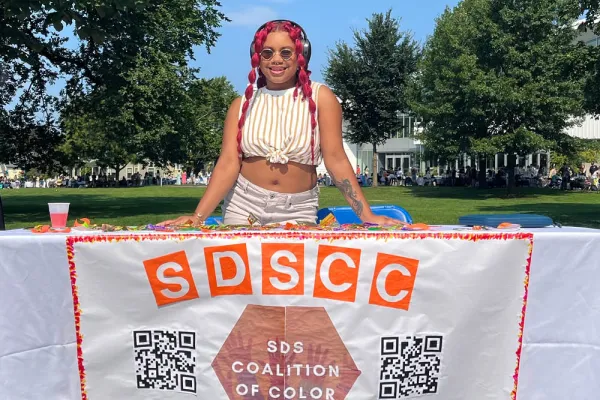Opening Pathways for Students in Data Sciences
Research & Inquiry

Published February 1, 2023
Aushanae Haller ’23J sees data science as “a Sherlock Holmes type of thing. You sort through data, analyze it and find a story.”
Haller first became interested in the subject in high school and took some programming workshops while earning an associate’s degree at a community college in Texas. But it was her SDS 192 Introduction to Data Science course at Smith that truly sparked her passion.
“There’s a steep learning curve, but once you get through it, data science is really satisfying,” says Haller.
At Smith, Haller participated in the college’s Data Sciences Corps, serving as a teaching assistant for students in data science classes at Smith and Holyoke Community College.
She also supported students interested in statistics and data science as chair of Smith’s SDS Coalition of Color. “I want to help students of color find this field and know it’s a possibility for them,” says Haller, who is currently applying to graduate degree programs in machine learning. “I think having a role model is really important.”
Drawing more students like Haller to the discipline is one of the goals of the Data Sciences Corps, a program that invites students to work with area nonprofits on practical data-science needs. Associate professor Ben Baumer—who launched the corps in 2019 with support from the National Science Foundation—says more than 100 students from across the Five Colleges have since participated in the program.
In addition to creating real-world learning experiences for students, Baumer has conducted summer teaching workshops for area community college faculty. At Holyoke Community College, those workshops led to proposals for a new data science program and professional development for faculty modeled after the Smith Data Sciences Corps, says Ileana Vasu, a professor and chair of the mathematics department at HCC.
Baumer is now collaborating with colleagues to build better pathways to data science studies for students transferring from two-year to four-year colleges. “Bachelor’s degree institutions are offering degrees in data sciences, but two-year colleges really aren’t,” he says. “That’s the problem we are trying to solve.”
Baumer recently co-authored a paper in the Harvard Data Science Review that offers suggestions for eliminating barriers to the field for students who begin their academic careers at community college.
“Data Science Transfer Pathways from Associate’s to Bachelor’s Programs” proposes adding a data science option to the map of degree programs listed on the state website, MassTransfer. A specific curricular alignment between data science programs at Bunker Hill Community College and the University of Massachusetts Dartmouth could serve as a model for pathways between other colleges in the state.
“We want to leverage what we’ve learned from our Data Science Corps program and create a structure that works for students from the beginning,” Baumer says. “For Smith, it’s an opportunity for us to walk the walk a bit more when it comes to providing opportunities for students from two-year colleges.”
Opening pathways for transfer students will help boost diversity in statistical and data sciences, where studies show women and people of color remain underrepresented.
The inequities show up early, says Smith associate professor Albert Y. Kim, who teaches the introductory class that inspired Haller to major in data sciences.
“A trend that has emerged in recent years is that the better resourced high schools are teaching kids computer programming, but the less advantaged schools are not,” Kim says. “That variation in background leads to a variation in student confidence” that keeps some from trying and pursuing data science in college.
In his classes, Kim aims to encourage students—even those with little prior experience with statistics or programming—to “share stories behind data” and build skills with each assignment. Among the stories students have chosen to explore are data sets revealing health inequalities, food deserts, and gender inequities in film.
“When students see themselves in a particular data set and they have the tools to work with this data, it empowers them,” Kim says. “Especially those students from marginalized groups who may not be used to having their stories heard.”
Haller says that approach helped her overcome her own hesitation about delving into programming and statistics.
“When I was first considering majoring in data science, I talked to Professor Kim about how the field really lacked women of color. I’m a Black woman so I was concerned about the likelihood of succeeding, given my identity,” she says. “He told me ‘we have a long way to go but that shouldn’t discourage you.’ He made it easy for me to learn.”
Haller says that while she still likes the computer science side of data science more than the math, she has gained confidence about her skills in the discipline. “It’s like learning a language,” she says. “And that takes time.”
“Smith’s hands-on approach to data science is very helpful,” adds Haller. “When I’m on interviews I can say I have professional experience in working with data. I have real work to show!”
In her time at Smith, Aushanae Haller ’23J helped support fellow students of color in data sciences.